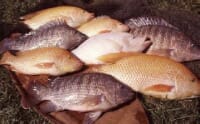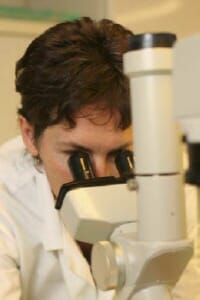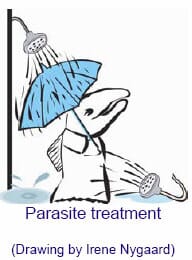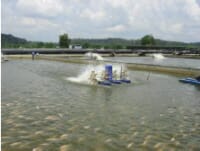First a general introduction of tilapia diseases was in Newsletter 11, followed by an article on Streptococcosis (Newsletter 12) and an overview of Columnaris disease (Newsletter 13). The severity of parasitic infections in tilapia is increasing with the intensification of culture systems. Therefore, the focus of this present article will be parasitic diseases of tilapia and possible control measures.
Parasite screening and etiology of major parasites affecting tilapia
Understanding the etiology of parasitic disease is of crucial importance as it determines the choice of a potential treatment.

Unlike bacterial or viral diseases for which it is necessary to identify the micro-organism to the species level before implementing an adapted vaccination strategy, the identification of parasites to the genus level is generally sufficient to implement an effective therapeutic or prophylactic strategy. Therefore, the only elements needed for an effective parasite diagnosis at the farm level are a light microscope and a basic knowledge of parasite taxonomy, size and morphology.

Parasite diagnosis should start by an external gross observation of the fish to check for the presence of larger parasites such as leeches and crustacean copepods. In addition, an infestation with a digenean trematode might be suspected when yellow or white grubs are seen on the skin. Then, parasite screening should be continued by observation of a skin and gill scrape by light microscopy at X40 and X100 magnification. At these magnifications, the typical shape and movements of protozoan ciliates such as Trichodina and Ichthyophthirius multifiliis, presence of inert and opaque Amyloodinium trophonts, or the presence of monogenean parasites can be observed. Similarly, the presence of metacercariae of digenean trematodes can be demonstrated in a skin grub through observation of a fresh smear under light microscopy.
Once the identity of the parasitic is determined, the severity of a parasite infestation is assessed by the number of parasites affecting each fish. Generally, the presence of a single or small number of individual parasites per fish is not an alarming factor. However, the presence of a massive number of parasites on each fish might constitute a real threat to the fish population and should require immediate action.
Therefore, routine parasite screening is an important part of good health management and should be done on a regular basis to allow for rapid action if needed. Parasites affecting tilapia can be classified into several major groups: protozoan ciliates, dinoflagellates, monogenean and digenean trematodes, crustacean copepods and hirudidae. The following table presents a short description of some of the most serious parasites in tilapia.
|
Illustration of major parasites of Tilapia, associated clinical signs, epidemiology and possible treatments |
||||
| PARASITE | Disease signs | Epidemiology /risk factors | Possible treatments | |
|---|---|---|---|---|
| Ciliates | Trichodina spp. (Trichodina in gill wet mount) |
Erratic swimming Opened operculum Scraping against walls Jumping out of water Erosion of fins, skin ulcers Gill hyperplasia | Massive mortality in hatchery and nursery phases | Salt bath Formalin bath Hsup2;O² bath KMnO4 bath |
Ichthyophthirius multifilis (Ich on skin wet ount) |
Appearance of white spots on skin Thick mucus on skin Stunted growth and mortality | Most severe in larval stages Problem in recirculation system | Repeated formalin bath Increased salinity | |
| Dinoflagellates | Amyloodinium spp. (Trophont in gill filament) |
Decreased appetite Flashing Accumulation of mucus | Brackish water 10-15 ppt Does not occur in freshwater | H2O&2bath |
| Trematodes | Digenena (Clinostomum spp) Metacercariae from wet mount of muscle) |
Grubs (yellow or white) on the skin. Skin haemorrhage and death if mass penetration of the parasite | Occur in pond farming when snails and birds are present | Remove or eradicate snails from the pond Prevent bird access to the farm |
Monogenean Dactyolgyrus spp (Adult on skin wet mount) |
Skin darkening Fin erosion Excessive mucus Rapid movement of operculum Emaciation in young fish | Juvenile and fingerling stages | Formalin bath H2O2 bath | |
Argulus sp.  (adult from fish skin) |
Skin irritation Loss of condition Associated secondary skin bacterial infection | Severe in larval stages and fingerlings | Organophosphates | |
| Crustaceans Copepods | Lernea spp. (adult from fish skin) |
Rub against sides of container Whitish spots of curled up worms embedded in the skin | Can affect mouth breeding | Organophosphates |
| Hirudidae | Leeches (adults on skin of fish) |
High number of leeches on an adult fish induce anemia | Severe in early stages Affect fish already weakened by another disease | Organophosphates |
Epidemiology and risk factors for parasitic diseases in tilapia
Parasites are part of the normal environment. There are several factors that influence the prevalence and severity of a parasitic disease. These factors are biological factors directly related to the tilapia and environmental factors related to the water body and culture system.
Biological factors:
- Age: What is true for fish in general is also true for tilapia in particular: Younger fish are more susceptible than adults. For example, newly hatched and juvenile tilapia are extremely sensitive to protozoan parasites. Particular attention to parasite screening is necessary at these stages to ensure maximal survival.
- Stress: Husbandry practices such as overcrowding and environmental changes in water quality can compromise the immune system of the tilapia and render it more susceptible to parasite infestations. Parasite numbers will invariably increase on weakened fish. Parasitic infestations may result in the fish population being more prone to secondary bacterial or viral infections directly via skin damage or by inducing physiological fatigue or immunosuppression. Vice-versa, it is common to observe parasites in fish primarily infected by a bacterial disease such as Streptococcosis.
- Nutrition: If the diet is inadequate, the fish immune system can be depressed and will not tolerate high parasitic burdens. First feeding and early stage diets are particularly important in assisting the fish to survive parasitic infestations.
- High stocking densities: High stocking densities cause stress and facilitate parasitic transmission. Direct transmission from fish to fish is used by protozoan ciliates and monogenean trematodes. It is much easier for the parasite to find a host in high density populations and this also allows the parasite to reproduce more rapidly and effectively.
Environmental factors:
- Salinity: As some parasites only survive in brackish water and others only tolerate freshwater, salinity is an important factor influencing infestation with a specific parasite. For instance, dinoflagellates such as Amyloodinium spp., can only survive in brackish and marine water, therefore, this parasite does not occur in freshwater. In contrast, some species of Trichodina can only tolerate freshwater and die with as little as 5ppt of salt in the water.
- Water quality: Poor water quality parameters such as high organic matter, high ammonia, low dissolved oxygen and high bacterial load can create a suboptimal environment that can be stressful for the fish and lead to a higher incidence of parasitic outbreaks.
- Culture system: Each culture system has its own characteristics. For instance, tanks or cages, which hold high densities of fish, are a good environment for the transmission of ectoparasites with a direct life cycle such as monogenean trematodes. Earthen ponds are a more complex environment with vegetation where parasites such as crustacean copepods or leeches can lay eggs. The mud can be a reservoir for cysts of dinoflagellates such as Amyloodinium or invertebrates acting as intermediate hosts such as snails for digenean trematodes. The bigger the pond, the more difficult it is to control the parasite population as it is more open to fish predators which can seed eggs and other parasite stages. Recirculation systems have their own set of problems relative to parasitism: due to the build-up of sediment, slow turn over of water, recirculation systems also favor the growth and concentration of parasites. Therefore, particular vigilance is necessary when introducing fish or fish eggs in these systems.
Preventive measures and possible treatment for parasitic diseases in tilapia

We often say that prevention is better than cure for viral and bacterial diseases. This saying is also true when it comes to parasites. As these organisms are part of the normal fish environment, avoidance is impossible and we have to learn how to live with them. The nature of parasites may vary depending on farming systemsand country. Therefore, routine parasite screening of healthy and sick fish is a major component of the prevention strategy in order to understand which parasites must be watched out for in a given farm.
Indeed, conducting weekly surveys over one entire year should give a complete overview of the parasitic fauna present in the farm and demonstrate variations in the incidence and prevalence due to seasonality, salinity and temperature. Once parasitic fauna have clearly been identified, it is important to adapt some of the farming practices based on the biology of parasites present in the farm. For instance, it is common practice for tilapia hatcheries to keep water salinity between 5 and 10 ppt in order to control the population of protozoan ciliates such as Trichodina. In extensive earthen pond systems, the biological control of snails and birds is the most effective strategy to break the cycle of digenean trematodes and avoid their presence in ponds.
Depending on the nature of parasites present in the farm and on chemicals legally authorized in the farming country, there are several potential chemicals that can be applied by bath, such as salt, formalin, H2O2 and KMnO4. However, dose and duration of treatment must be adapted to several parameters:
- The age and physiological condition of the fish: Juveniles are more sensitive than adults to chemical treatment and can’t tolerate a similar concentration of chemical.
- The availability of pure oxygen or aeration during the treatment: During some of the chemical treatments, such as a formalin bath, the concentration of dissolved oxygen present in the water is reduced. Consequently, it is necessary to compensate that by artificial water oxygenation.
- The type of culture system: A highly concentrated treatment can be implemented by using a tarpaulin system on a cage but this becomes impractical and not economical when applied to a large body of water such as a pond. In such systems, lower doses of chemical for a longer duration of immersion should be tested.

Therefore, each treatment must be evaluated on a small scale for safety and efficacy before implementation at the farm level. In addition, it should be remembered that the application of any chemical treatment may have unwanted side effects. For instance, salt water is an effective treatment for protozoan ciliates; however, pumping seawater without filtration into the farm can result in the concomitant introduction of unwanted bacterial pathogens. Moreover, formalin, another possible chemical treatment for protozoan ciliates, should be applied with care in ponds as it might induce plankton die-offs.
Finally, simple health management measures should be implemented as much as possible to reduce the introduction and spread of parasites at the farm level. Indeed, before introduction of new fish in a farm or during transfer from one unit to another, fish should receive a prophylactic parasite treatment. Moreover, the farming equipment should be kept separated between different units of the farm to avoid horizontal spreading of parasites. After each cycle, fish holding systems should be properly cleaned and disinfected to limit the build up of parasites from one cycle to the next. Ultimately, as stressed fish are more susceptible to parasites, it should be the golden rule for every farmer to keep stress level as low as possible, especially during and after any event or procedure which causes stress, such as transportation, handling, a change in seasonality and/or a change in water quality.
June 2007


